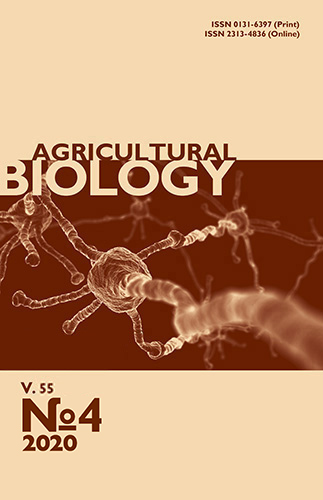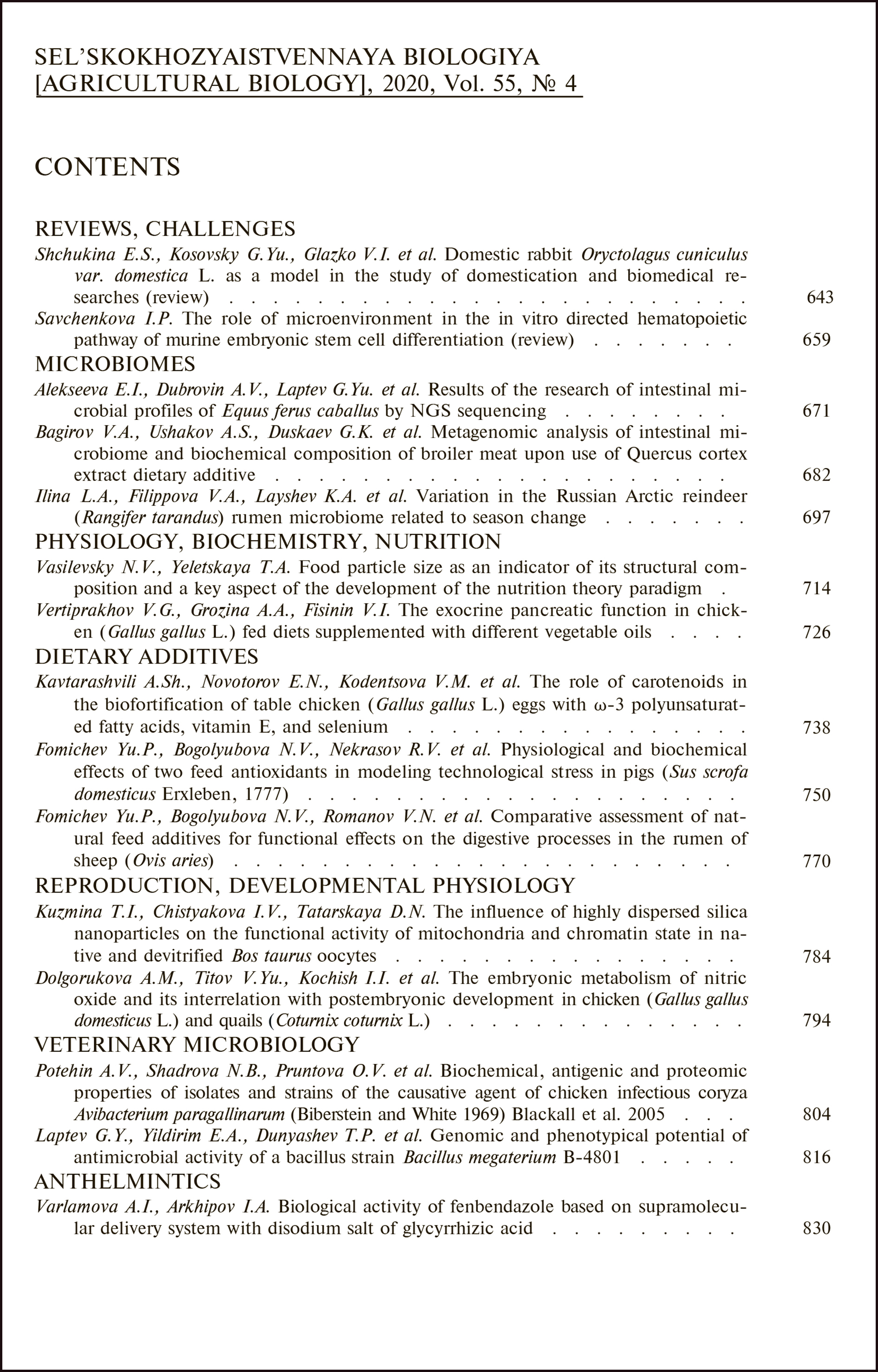doi: 10.15389/agrobiology.2020.4.784eng
UDC: 636.2:591.465.12:576:576.3/.7.086.83:591.04
Acknowledgements:
The work was performed according to the theme of the project No. 18-016-00147A funded by the Russian Foundation for Basic Research.
THE INFLUENCE OF HIGHLY DISPERSED SILICA NANOPARTICLES ON THE FUNCTIONAL ACTIVITY OF MITOCHONDRIA AND CHROMATIN STATE IN NATIVE AND DEVITRIFIED Bos taurus OOCYTES
T.I. Kuzmina1, I.V. Chistyakova1, D.N. Tatarskaya2
1All-Russian Research Institute for Farm Animal Genetics and Breeding — branch of Ernst Federal Science Center for Animal Husbandry, 55А, Moskovskoe sh., St. Petersburg—Pushkin, 196625 Russia, e-mail prof.kouzmina@mail.ru, tjerena7@gmail.com (corresponding author ✉);
2Pushkin Leningrad State University, 10, Petersburg Sh., St. Petersburg—Pushkin, 196605, e-mail ianatatarskaa587@gmail.com
ORCID:
Kuzmina T.I. orcid.org/0000-0002-4218-6080
Tatarskaya D.N. orcid.org/0000-0002-8834-1912
Chistyakova I.V. orcid.org/0000-0001-7229-5766
Received May 28, 2020
Mitochondria are the only cellular compartments which generate and transform energy in the cell. These organelles are among the first to respond to changes in extra- and intracellular conditions (e.g., ionic homeostasis, dehydration level, temperature). Exposition to ultra-low temperatures, due to lipid peroxidation, causes ATP synthetase disorders and destruction of genetic material (E.A. Novocherkina et al., 2016). Highly dispersed silica nanoparticles (nHDS) can be proposed as cytoprotectors. An amorphous form of silicon dioxide, or highly dispersed silica, which exhibits its biological activity through high adsorption capacity, reduces the concentration of ions and biopolymers upon cell dehydration during cryopreservation, thus preventing a sharp change in the osmolar equilibrium between the intra- and extracellular environment (T.T. Turov et al., 2011). This paper deals with the first report of the increase in cryoresistance and maturation rate of donor Bos taurus oocytes due to exposure to nHDS during vitrification and in vitro culture, which ensures higher functional activity of mitochondria and preserves structural properties of chromatin of native and devitrified (DV) oocytes. The study aimed to identify the impact of nHDS on functional activity of mitochondria and chromatin state of cows’ native and devitrified oocytes during in vitro culture. In the experiments, we used oocyte-cumulus complexes (OCCs) of Holsteinized cows. The oocytes with homogeneous cytoplasm surrounded by five or more layers of cumulus cells were subjected to vitrification. OCCs intended for vitrification were successively exposed to three solutions of cryoprotective agents (CPAs) based on T-199 medium with 10 % fetal bovine serum (FBS, HyClone, Great Britain), the CPA-1 containing 0.7 M dimethyl sulfoxide (DMSO) + 0.9 M ethylene glycol (EG) (for 30 s), CPA-2 (1.4 M DMSO + 1.8 M EG (for 30 s), and CPA-3 (2.8 M DMSO + 3.6 M EG + 0.65 M trehalose) (for 20 s). The oocytes in straws were plunged into liquid nitrogen. After thawing, the oocytes were washed with T-199 medium containing 0.25 M, 0.19 M, and 0.125 M trehalose, and finally with T-199 medium. In the test group of oocytes, highly dispersed silica nanoparticles (nHDS, 4-17 nm, mass concentration 0.001 %) synthesized by high-temperature hydrolysis were added to the CPAs, devitrification solutions and washing solutions. In the control group, native and devitrified oocytes were cultured for 24 hours in maturation medium, the T-199 with 106 granulosa cells/ml supplemented with 10 % fetal bovine serum and 50 ng/ml bovine prolactin (38.5 °C, 90 % humidity, and 5 % CO2 atmosphere). In the test group, the maturation medium for native and devitrified oocytes was supplemented with nHDS at a final concentration of 0.001 %. Mitochondrial activity was measured by fluorescence intensity (FI) of MitoTracker Orange CMTMRos (Thermo Fisher Scientific, UK) in µA. In a series of experiments on identification of the nHDS effects on the nuclear maturation of female gametes, oocytes were exposed for 5-10 min to 0.9 % sodium citrate solution and mechanically released from cumulus cells with a preparation needle. Then the cells were placed on a glass slide and fixed with methanol:acetic acid solution (3:1). The dry-air preparations were stained with azure-eosin by Romanovsky-Giemsa method. In DV oocytes influenced by nHDS, the FI of MitoTracker Orange CMTMRos probe increased from 77±6.3 μA to 169±12.8 μA (p < 0.05). The functional activity of mitochondria of DV oocytes treated with nHDS increased from 169±12.8 μA to 181±7.7 μA (p < 0.05) during the diplotene to the metaphase I stages, and subsequently decreased to 141±11.2 μA at metaphase II stage, what is probably associated with the completion of nuclear and cytoplasmic maturation of oocytes. When assessing the chromatin state of oocytes in the nHDS-treated group, we revealed a decrease in the number of oocytes with chromatin degeneration at diplotene and metaphase II stages compared to those in the nHDS-untreated DV oocytes (40 % vs. 21 %, and 59 % vs. 38 %, p < 0.01), that is probably associated with the DNA repair. In general, our findings reveal a positive effect of nHDS on the functional activity of mitochondria and the chromatin state in DV female gametes of Bos taurus. The obtained results expand views and available information on the functioning of cell compartments at ultra-low temperatures and the mechanisms of nHDS action on female gametes.
Keywords: oocyte, vitrification, highly dispersed silica nanoparticles, functional activity of mitochondria, MitoTracker Orange CMTMRos,chromatin, Bos taurus.
REFERENCES
- Xu H.F., Hao B.T., Liu L.J., Tang L.L., Liu B.L. Calorimetric studies on thermal properties of nano-cryoprotectant solutions during vitrification. CryoLetters, 2016, 37(6): 406-410.
- Li W., Zhou X., Dai J., Zhang D., Liu B., Wang H., Xu L. Effect of hydroxyapatite nanoparticles on MII-stage porcine oocytes vitrification and the study of its mechanism. Biochemical Engineering Journal, 2013, 30(4): 789-793.
- Turov V.V., Barvinchenko V.N., Krupskaya T.V., Gun'ko V.M., Chekhun V.F. Biotekhnologiya, 2011, 4(4): 34-48 (in Russ.).
- Rubio L., Pyrgiotakis G., Beltran-Huarac J., Zhang Y., Gaurav J., Deloid G., Spyrogianni A., Sarosiek K., Bello D., Demokritou P. Safer-by-design flame-sprayed silicon dioxide nanoparticles: the role of silanol content on ROS generation, surface activity and cytotoxicity. Particle and Fibre Toxicology, 2019, 16(1): 40 CrossRef
- Galagan N.P., Gun’ko V.M., Porkhun N.G., Novikova E.A., Turov V.V. Dopovidi Natsional'noї akademiї nauk Ukraїni, 2012, 5: 126-133 (in Russ.).
- Savchenko D.S. Meditsina i obrazovanie v Sibiri, 2013, 6: 23-30 (in Russ.).
- Al-Zubaidi U., Liu J., Cinar O., Robker R.L., Adhikari D., Carroll J. The spatio-temporal dynamics of mitochondrial membrane potential during oocyte maturation. Molecular Human Reproduction, 2019, 25(11): 695-705 CrossRef
- Pozhilova E.V., Novikov V.G., Levchenkova O.S. Obzory po klinicheskoi farmakologii i lekarstvennoi terapii, 2014, 12(3): 13-19 (in Russ.).
- Yoon S.Y., Eum J.H., Cha S.K., Yoon T.K., Lee D.R., Lee W.S. Prematuration culture with phosphodiesterase inhibitors after vitrification may induce recovery of mitochondrial activity in vitrified mouse immature oocytes. Biopreservation and Biobanking, 2018, 16(4): 296-303 CrossRef
- Galagan N.P., Klymenko N.Y., Orel I.L., Novikova E.A., Turov V.V. Biofunctional nanomaterials based on ultra-fine silica, protein and aminocarbohydrates. Biopolymers and Cell, 2010, 26(3): 205-213 CrossRef
- Chistyakova I.V., Kuzmina T.I., Stanislavovich T.I., Kovtun S.V. Effects of highly dispersed silica nanoparticles on the cryoresistance of the bovine cumulus-oocyte complexes. Cryobiology, 2018, 85: 176 CrossRef
- Kuz'mina T.I., Chistyakova I.V. Aktual'nye voprosy veterinarnoi biologii, 2019, 3(43): 8-12 (doi: 10.24411/2074-5036-2019-10031) (in Russ.).
- Kuz'mina T.I., Stanislavovich T.I., Molchanov A.V. Agrarnyi nauchnyi zhurnal, 2019, 3: 29-34 (doi: 10.28983/asj.y2019i3pp29-34) (in Russ.).
- Novoderezhkina E.A., Zhivotovskii B.D., Gogvadze V.G. Molekulyarnaya biologiya, 2016, 50(1): 51-68 CrossRef (in Russ.).
- Kim B., Yoon S.-Y., Cha S.K., Kwak K.H., Fissore R.A., Parys J.B., Yoon T.K., Lee D.R. Alterations in calcium oscillatory activity in vitrified mouse eggs impact on egg quality and subsequent embryonic development. Pflügers Archiv — European Journal of Physiology, 2011, 461: 515-526 CrossRef
- Mostek A., Słowińska M., Judycka S., Karol H., Ciereszko A., Dietrich M.A. Identification of oxidatively modified proteins due to cryopreservation of carp semen. Journal of Animal Science, 2018, 96(4): 1453-1465 CrossRef
- Xiao L., Zhao D., Chan W.-H., Choi M.M.F., Li H.-W. Inhibition of beta 1-40 amyloid fibrillation with N-acetyl-L-cysteine capped quantum dots. Biomaterials, 2010, 31(1): 91-98 CrossRef
- Shin W.S., Di J., Cao Q., Li B., Seidler P.M., Murray K.A., Bitan G., Jiang L. Amyloid β-protein oligomers promote the uptake of tau fibril seeds potentiating intracellular tau aggregation. Alzheimers Research and Therapy, 2019, 11(1): 86 CrossRef
- Sukhanova A., Poly S., Bozrova S., Lambert E., Ewald M., Karaulov A., Molinari M., Nabiev I. Nanoparticles with a specific size and surface charge promote disruption of the secondary structure and amyloid-like fibrillation of human insulin under physiological conditions. Frontiers in Chemistry, 2019, 7: 480-486 CrossRef
- Desai J., Foresto-Neto O., Honarpisheh M., Steiger S., Nakazawa D., Popper B., Buhl E.M., Boor P., Mulay S.R., Anders H.-J. Particles of different sizes and shapes induce neutrophil necroptosis followed by the release of neutrophil extracellular trap-like chromatin. Scientific Reports, 2017, 7(1): 15003 CrossRef
- Sun L., Li Y., Liu X., Jin M., Zhang L., Du Z., Guo C., Huang P., Sun Z. Cytotoxicity and mitochondrial damage caused by silica nanoparticles. Toxicology in Vitro, 2011, 25(8): 1619-1629 CrossRef
- Barros V.R.P., Monte A.P.O., Santos J.M.S., Lins T.L.B.G., Cavalcante A.Y.P, Gouveia B.B., Müller M.C., Oliveira Junior J.L., Barberino R.S., Donfack N.J., Araújo V.R., Matos M.H.T. Effects of melatonin on the in vitro growth of early antral follicles and maturation of ovine oocytes. Domestic Animal Endocrinology, 2019, 71: 106386 CrossRef
- Savchenko D.S. Vestnik novykh meditsinskikh tekhnologii, 2013, 20(4): 44-47 (in Russ.).
- Yang Y., Du X., Wang Q., Liu J., Zhang E., Sai L., Peng C., Lavin M.F., Yeo A.J., Yang X., Shao H., Du Z. Mechanism of cell death induced by silica nanoparticles in hepatocyte cells is by apoptosis. International Journal of Molecular Medicine, 2019, 44(3): 903-912 CrossRef
- Murugadoss S ., Lison D., Godderis L ., Van Den Brule S., Mast J., Brassinne F., Sebaihi N., Hoet P.H. Toxicology of silica nanoparticles: an update. Archives of Toxicology, 2017, 91(9): 2967-3010 CrossRef
- Li Y., Duan J., Chai X., Yang M., Wang J., Chen R., Sun Z. Microarray-assisted size-effect study of amorphous silica nanoparticles on human bronchial epithelial cells. Nanoscale, 2019, 11(47): 22907-22923 CrossRef












